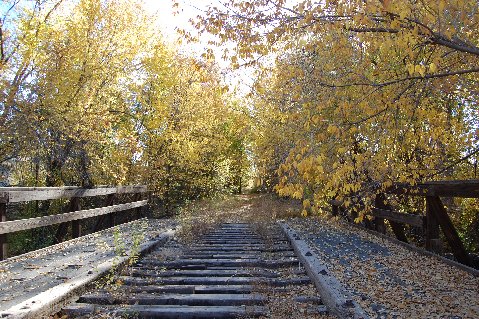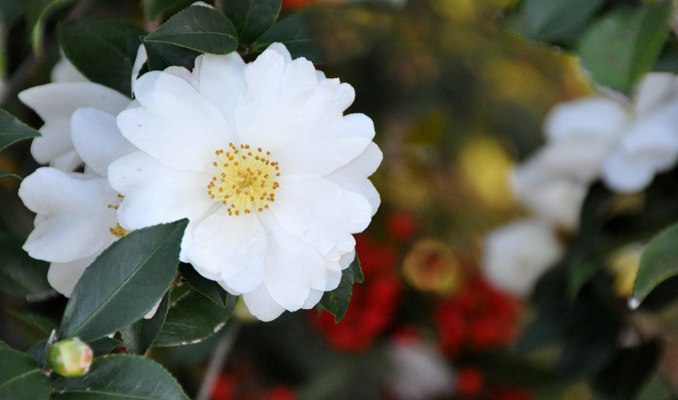 A couple of weeks ago we dispersed the final applications of plant food to keep our landscapes healthy through winter. “Crabgrass and Weed Preventer” was applied at the same time to keep winter growing weeds away until spring. This week the same question kept coming to me over and over and over, “Do I have to work these additives into my rock lawn and garden soil?” The answer is no. Let nature do this work for you. The winter moisture in the weeks and months ahead will take care of moving these additives into the ground, saving us from many work-filled hours in the yard. This is a difficult principle for some gardeners to accept. But it is true: simply chuck-and-go and the gardener’s work is done.
A couple of weeks ago we dispersed the final applications of plant food to keep our landscapes healthy through winter. “Crabgrass and Weed Preventer” was applied at the same time to keep winter growing weeds away until spring. This week the same question kept coming to me over and over and over, “Do I have to work these additives into my rock lawn and garden soil?” The answer is no. Let nature do this work for you. The winter moisture in the weeks and months ahead will take care of moving these additives into the ground, saving us from many work-filled hours in the yard. This is a difficult principle for some gardeners to accept. But it is true: simply chuck-and-go and the gardener’s work is done.
Now, if you haven’t fed your landscape this autumn, it’s not too late. Everything in the yard should be fed with an all-natural ‘All Purpose Plant Food’ 7-4-4, before the next storm arrives. Think of it as laying out a Thanksgiving feast for your plants. Then, in spring, you will enjoy a richer-looking landscape, deeper evergreens, and more fragrant early spring blooms from lilacs, forsythias, and camellias.
~~ ~~ ~~ ~~ ~~ ~~ ~~
Over the years the Goshiki Holly has become one of my favorite winter evergreens for my container gardens. In Japanese ‘Goshiki’ means “Holly showing five different leaf colors”, and it does just that! Each evergreen bush has leaf colors in varied greens, golds, reds, and white. “Energized freshness that sparkles through winter” is a suitable definition for this plant that thrives in winter and loves being planted in autumn. The unusual foliage mixes well with winter blooming pansies, violas, kales, and dusty millers.
~~ ~~ ~~ ~~ ~~ ~~ ~~
 Plant of the Week is the Ice Angel Camellia, another large leafed evergreen that has just gone into bloom. Yes, you read that right. Only a few plants bloom as the weather cools and this hardy camellia is a real show off as temps begin to dip. Hardier than all other camellias you may have grown in California, this new introduction loves the cold, and is capable of surviving winters well below the subzero mark. The plant is easily trained as an espalier to soften walls and fence lines. Its vividly white flowers are baseball sized and so impressive that I don’t put this specimen directly into my garden. I keep this four-foot tall evergreen right in the grower’s pot and enjoy the winter blooms at our front door. After her winter bloom cycles are finished I will plant this beauty in my garden. With the blink of an eye you can change the look of your home with this gorgeous new bloomer by moving it from the front door, deck, or patio and into the garden.
Plant of the Week is the Ice Angel Camellia, another large leafed evergreen that has just gone into bloom. Yes, you read that right. Only a few plants bloom as the weather cools and this hardy camellia is a real show off as temps begin to dip. Hardier than all other camellias you may have grown in California, this new introduction loves the cold, and is capable of surviving winters well below the subzero mark. The plant is easily trained as an espalier to soften walls and fence lines. Its vividly white flowers are baseball sized and so impressive that I don’t put this specimen directly into my garden. I keep this four-foot tall evergreen right in the grower’s pot and enjoy the winter blooms at our front door. After her winter bloom cycles are finished I will plant this beauty in my garden. With the blink of an eye you can change the look of your home with this gorgeous new bloomer by moving it from the front door, deck, or patio and into the garden.
~~ ~~ ~~ ~~ ~~ ~~ ~~
As our weather cools we power up heaters to keep us warm indoors. Any heat source not only warms our living quarters but also dramatically lowers indoor humidity. Our skin is dyer than usual and so are our plants. You will find that the more we run our heaters the faster our houseplants’ soil dries. Make sure to check the soil of indoor plants frequently until you get used to the rhythm of winter watering. This is the time of year to invest in a good moisture meter. A moisture meter is a useful tool to have on hand, a good one usually going for under $15. This handy gizmo is useful year-round for houseplants and in early spring for outdoor garden containers.
~~ ~~ ~~ ~~ ~~ ~~ ~~
Garden Alert! The first of winter’s storms will find many of us scrambling to bring plants indoors to protect them from the cold. Unfortunately, at the same time a pesky black gnat comes in seeking refuge. Fungus gnats love to live in houseplant soil and since they are drawn to the lights of a computer screen, the I-Pad, bright windows, and any other light source, they become nuisances to our indoor living. If left unchecked they can spread and kill all indoor plants. S’pose there’s any solution to this gnat-ty problem?
 There are two solutions for eliminating these gnats. One is to keep the pests from flying around the house and spreading from plant to plant, and the other is to prevent them from living in a houseplant’s soil. The first solution is a glorified version of traditional flypaper. A ‘Sticky Whitefly Trap‘ is an organic solution that attracts flying adult gnats to its brightly colored strip of paper where they get stuck and die. Some folks stick a trap in the soil of each houseplant in every room. This prevents mature adults from 1) spreading and laying more eggs, and 2) from “bugging” you while you’re trying to check emails.
There are two solutions for eliminating these gnats. One is to keep the pests from flying around the house and spreading from plant to plant, and the other is to prevent them from living in a houseplant’s soil. The first solution is a glorified version of traditional flypaper. A ‘Sticky Whitefly Trap‘ is an organic solution that attracts flying adult gnats to its brightly colored strip of paper where they get stuck and die. Some folks stick a trap in the soil of each houseplant in every room. This prevents mature adults from 1) spreading and laying more eggs, and 2) from “bugging” you while you’re trying to check emails.
‘Systemic Insect Granules’ are a long-term solution to this pesky problem. The granular deterrent is sprinkled at the base of houseplants and watered in by hand. As the water penetrates the soil it pulls the granules along with it, killing the maggot stage of these pests. By eliminating the maggots in a plant’s soil the plant is allowed to thrive. If ignored, the pests eventually will take over and kill every plant in that room, moving on to other rooms in search of new plants to infect. Visit me for more exacting details, but with these bits of advice you will be considered “armed and dangerous”.
Until next week, I’ll see you in the garden center.

